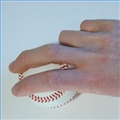Grip and action

The baseball is held with the open end of the horseshoe shape (where the seams are closest together) facing upward. The thumb is placed just beneath the bottom of the horseshoe, the index finger is curled against the top of the thumb, forming a tight circle to the side of the ball. The middle finger is then placed on the top of the ball and grips against the top seam, (the seam closest to the index finger). The ring finger is placed outside the other top seam loosely and the pinky is held on the side opposite the thumb; all fingers are spread apart. The grip is similar to the circle changeup, [1] but with different placement in regards to the seams.
Also, unlike the circle change, when throwing the screwball the middle finger applies the most pressure to the baseball, while the ring and pinky exert no pressure at all. For left-handed pitchers, as the middle finger presses hard down on the ball, their hand pronates (turns) inwardly in a clockwise manner near the end of the pitching motion, until much of the hand is beneath the ball. Conversely, right-handed pitchers turn their hand counter-clockwise. [2]